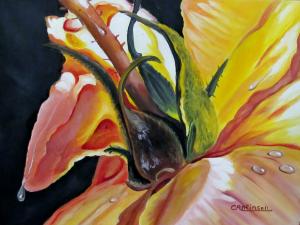Looking for design inspiration? Browse our curated collections!
June 22nd, 2012 - 06:35 PM

When I first started painting, I’d get so excited once the drawing and under painting were finished. Even more excited when the first real coat of paint; the sky, the background items filled the canvas. “Why, I’m almost done:” I foolishly replied.
What I’ve learned since is that after the canvas is covered, the “real work” begins. Artwork isn’t a flash in the pan. You don’t slather a few coats of paint on and call it a day. Professionalism appears near the end, at the point a novice thinks his painting is finished. Most artists will attest: “It’s all in the details.”
The difficult part of any painting is the small and subtle brushwork that makes a canvas zing. It may be added coats of glaze that deepen color or thin films of paint to get smoothness. Chosen wisely, these areas create more depth, value, and selected highlights. Like the polish on an apple, the final details add sheen and realism.
Sometimes artists have clever ways to accomplish some of these tasks. In researching how to paint fish scales, I found that many sculptors of decoy fish actually use wedding veil fabric and spray paint through it with silver to spot the fish. They use another piece of veil, moving it a fraction, to spray another area with gold. The detailing is incredible.
Other fish painters may independently paint the scales, either dotting or using semi-circles of overlapping paint. An artist can gain knowledge by researching online or through practice and determination.
Visiting a fish market is a real plus. Better yet, buying a real fish and studying it, painting it makes a remarkable difference. One artist did just that. When the fish she bought started to stink, she’d buy another until she had the effect and detail she wanted in her painting.
Depending on the desire and style of the artist, the lighter the touch of the brush and the more spontaneous, the fresher and more energetic a painting appears. To achieve both detail and freshness requires forethought and practice.
The first water droplets I painted took me several tries to get it right. Luckily, I was using oil. Each time I made a mistake; I’d swipe off the droplet and start again. I soon learned to use less paint, outline the droplet first, shadow second, and then add the highlights as a final touch.
It is so much fun that the real skill comes in knowing when to stop. If you’re not careful, the whole canvas could be filled with droplets. The kicker is that a few well placed droplets make a stunning statement. Too many, and the painting shouts with noise and the droplets become distraction.
It’s the subtle additions that make all the difference: increased contrast to make the center of interest “pop;” a few well placed highlights; color intensity in areas to guide the eye through the painting. At the point when you think your painting is finished, it may just be the beginning of a long and thoughtful process that in the end will make your artwork memorable.
Comments
Thelma Harcum
11 Years Ago
Willingboro, NJ
Hello Carol, I love your blog and agree you must know when to stop. I love the flower in your blog and fine it very vibrant and rich in color. It looks authentic as if you could smell and touch it. I'll be visiting your art and gallery in a minute. Keep up the great work and much success to you. I'm new to the site and fined it amazing!